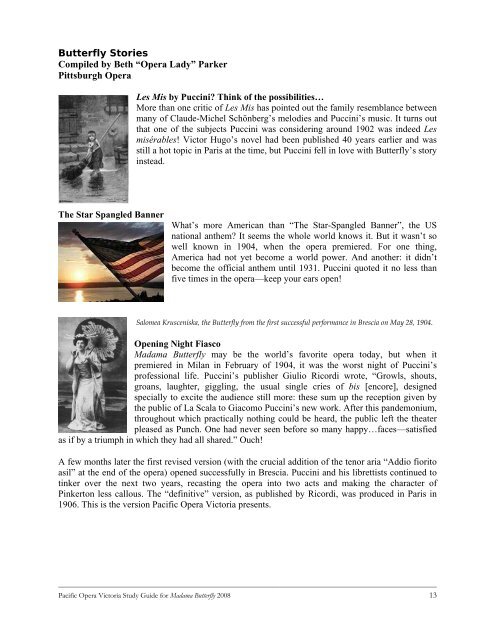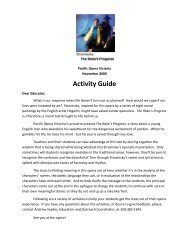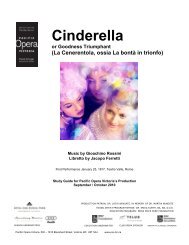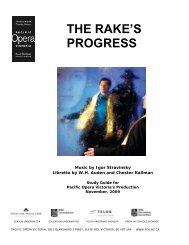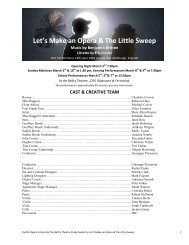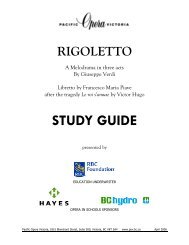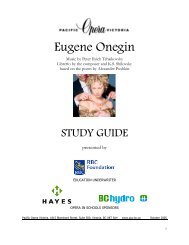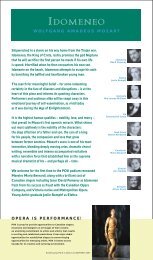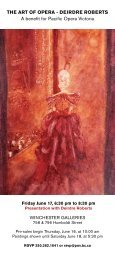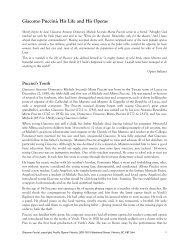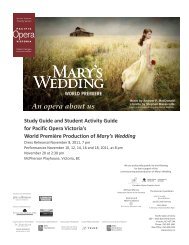Madama Butterfly Study Guide - Pacific Opera Victoria
Madama Butterfly Study Guide - Pacific Opera Victoria
Madama Butterfly Study Guide - Pacific Opera Victoria
Create successful ePaper yourself
Turn your PDF publications into a flip-book with our unique Google optimized e-Paper software.
<strong>Butterfly</strong> Stories<br />
Compiled by Beth “<strong>Opera</strong> Lady” Parker<br />
Pittsburgh <strong>Opera</strong><br />
Les Mis by Puccini? Think of the possibilities…<br />
More than one critic of Les Mis has pointed out the family resemblance between<br />
many of Claude-Michel Schönberg’s melodies and Puccini’s music. It turns out<br />
that one of the subjects Puccini was considering around 1902 was indeed Les<br />
misérables! Victor Hugo’s novel had been published 40 years earlier and was<br />
still a hot topic in Paris at the time, but Puccini fell in love with <strong>Butterfly</strong>’s story<br />
instead.<br />
The Star Spangled Banner<br />
What’s more American than “The Star-Spangled Banner”, the US<br />
national anthem? It seems the whole world knows it. But it wasn’t so<br />
well known in 1904, when the opera premiered. For one thing,<br />
America had not yet become a world power. And another: it didn’t<br />
become the official anthem until 1931. Puccini quoted it no less than<br />
five times in the opera—keep your ears open!<br />
Salomea Krusceniska, the <strong>Butterfly</strong> from the first successful performance in Brescia on May 28, 1904.<br />
Opening Night Fiasco<br />
<strong>Madama</strong> <strong>Butterfly</strong> may be the world’s favorite opera today, but when it<br />
premiered in Milan in February of 1904, it was the worst night of Puccini’s<br />
professional life. Puccini’s publisher Giulio Ricordi wrote, “Growls, shouts,<br />
groans, laughter, giggling, the usual single cries of bis [encore], designed<br />
specially to excite the audience still more: these sum up the reception given by<br />
the public of La Scala to Giacomo Puccini’s new work. After this pandemonium,<br />
throughout which practically nothing could be heard, the public left the theater<br />
pleased as Punch. One had never seen before so many happy…faces—satisfied<br />
as if by a triumph in which they had all shared.” Ouch!<br />
A few months later the first revised version (with the crucial addition of the tenor aria “Addio fiorito<br />
asil” at the end of the opera) opened successfully in Brescia. Puccini and his librettists continued to<br />
tinker over the next two years, recasting the opera into two acts and making the character of<br />
Pinkerton less callous. The “definitive” version, as published by Ricordi, was produced in Paris in<br />
1906. This is the version <strong>Pacific</strong> <strong>Opera</strong> <strong>Victoria</strong> presents.<br />
________________________________________________________________________________________________________<br />
<strong>Pacific</strong> <strong>Opera</strong> <strong>Victoria</strong> <strong>Study</strong> <strong>Guide</strong> for <strong>Madama</strong> <strong>Butterfly</strong> 2008 13


